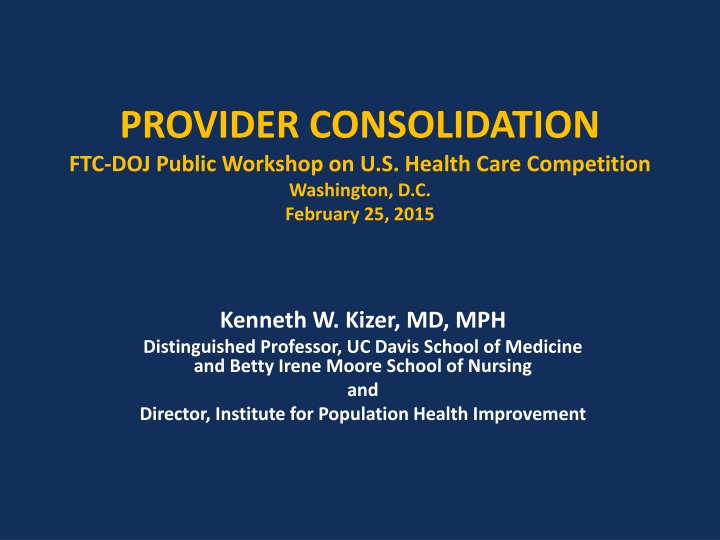
Clinical Integration and Provider Consolidation in U.S. Health Care
Explore the challenges and benefits of clinical integration and provider consolidation in U.S. health care, focusing on key functionalities and the importance of engaging physicians for successful outcomes. Learn about the core elements required for integrated patient care and the evolving landscape of healthcare systems. Stay informed on the latest developments shaping the future of healthcare delivery.
Download Presentation

Please find below an Image/Link to download the presentation.
The content on the website is provided AS IS for your information and personal use only. It may not be sold, licensed, or shared on other websites without obtaining consent from the author. If you encounter any issues during the download, it is possible that the publisher has removed the file from their server.
You are allowed to download the files provided on this website for personal or commercial use, subject to the condition that they are used lawfully. All files are the property of their respective owners.
The content on the website is provided AS IS for your information and personal use only. It may not be sold, licensed, or shared on other websites without obtaining consent from the author.
E N D
Presentation Transcript
PROVIDER CONSOLIDATION FTC-DOJ Public Workshop on U.S. Health Care Competition Washington, D.C. February 25, 2015 Kenneth W. Kizer, MD, MPH Distinguished Professor, UC Davis School of Medicine and Betty Irene Moore School of Nursing and Director, Institute for Population Health Improvement
PROVIDER CONSOLIDATION Driven by the need to achieve clinical integration New value-based payment models May be important for quality improvement of some services Essential for population health management Independent physicians an endangered species?? The rhetoric vs the reality of consolidation-derived efficiencies and quality improvements Cost Quality of care Service satisfaction Health outcomes Clinical integration is about integrating patient care, not organizations
CLINICAL INTEGRATION: Form vs Function Integrated patient care and integrated delivery system are not synonymous; full financial integration is not synonymous with effective clinical integration Integrated delivery system (IDS) is a generic term for a variety of organizational structures having varying degrees of administrative, financial and/or clinical integration; there is no standardized definition of what constitutes an IDS Integrated delivery systems do not necessarily produce integrated care e.g., VA early 1990s, DOD-Military Treatment Facilities Achieving clinical integration is dependent on key organizational functionalities, not a particular structure; no single organizational form has been shown to be superior to others for achieving integrated care
CLINICAL INTEGRATION: Core Functionalities A common vision of health care service delivery having Shared and widely understood clinical objectives and goals A patient-centric and population health focus Information management tools (e.g., EHRs, HIEs, data analytics) and other supporting infrastructure Policies and procedures for coordinating care across providers, settings, conditions, and time Team-based care Methods of accountability, including a performance management system that consistently measures and monitors clinical performance Strong clinical leadership that drives integrated care and engages front line providers Shared financial risks and rewards for clinical outcomes
Published on FierceHealthcare (http://www.fiercehealthcare.com) Healthcare systems fall short in physician engagement, docs report June 9, 2014 | By Julie Bird The problem is many organizations don't know how to bring physicians into their fold and have successful outcomes, said Angood. There is more to integration than recruitment and getting physicians to sign a contract, he said. Healthcare systems that engage with physicians can improve their recruitment and retention and improve their chances of reaching other high-priority goals Doctors who feel engaged are more likely to be satisfied in their work, according to a summary of the findings published online in the American Hospital Association's Hospitals & Health Networks Forum. But "engagement levels over the past three years have grown at a lukewarm pace, at best," according to the symmary by Physician Wellness Services consulting physicians Daniel Whitlock, M.D., M.B.A., and Robert Stark, M.D. The five most important elements to feeling engaged, according to the survey were: 1. Feeling respected for competency and skills 2. Feeling that opinions and ideas are valued 3. Maintaining a good relationship with peers 4. Achieving a good work/life balance 5. Having a voice in how the doctor's time is structured and used Peter Angood, MD CEO, ACPE February 2014 http://assets.fiercemarkets.net/public/Angood%20Print%204.25%20x%205.5.jpg
LESSONS FROM FTC, et al v. St. LUKES , et al
LESSONS FROM ST. LUKES 1. Assertions of improved efficiency and quality must be more than aspirational or speculative a. Need baseline performance data b. Evidence of improvement must be able to withstand scrutiny c. Improved functioning must be clearly linked to the consolidation 2. Employment is not required for physicians to gain access to electronic medical record systems or data analytics (population health management) tools
LESSONS FROM ST. LUKES 3. Asserting that a core number of primary care physicians is essential to provide integrated care is not supported by the evidence 4. Employment of physicians is not necessary to align incentives and transition to value-based payment nor required to achieve clinical integration






















